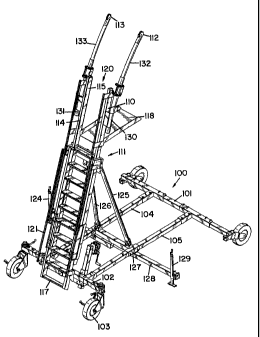Une partie des informations de ce site Web a été fournie par des sources externes. Le gouvernement du Canada n'assume aucune responsabilité concernant la précision, l'actualité ou la fiabilité des informations fournies par les sources externes. Les utilisateurs qui désirent employer cette information devraient consulter directement la source des informations. Le contenu fourni par les sources externes n'est pas assujetti aux exigences sur les langues officielles, la protection des renseignements personnels et l'accessibilité.
L'apparition de différences dans le texte et l'image des Revendications et de l'Abrégé dépend du moment auquel le document est publié. Les textes des Revendications et de l'Abrégé sont affichés :
| (12) Brevet: | (11) CA 2690528 |
|---|---|
| (54) Titre français: | SUPPORT MOBILE SERVANT A FIXER UN DISPOSITIF ANTICHUTE |
| (54) Titre anglais: | MOBILE MOUNT FOR ATTACHMENT OF A FALL ARREST SYSTEM |
| Statut: | Réputé périmé |
| (51) Classification internationale des brevets (CIB): |
|
|---|---|
| (72) Inventeurs : |
|
| (73) Titulaires : |
|
| (71) Demandeurs : |
|
| (74) Agent: | CASSAN MACLEAN IP AGENCY INC. |
| (74) Co-agent: | |
| (45) Délivré: | 2012-10-02 |
| (22) Date de dépôt: | 2004-05-07 |
| (41) Mise à la disponibilité du public: | 2005-11-07 |
| Requête d'examen: | 2010-01-20 |
| Licence disponible: | S.O. |
| (25) Langue des documents déposés: | Anglais |
| Traité de coopération en matière de brevets (PCT): | Non |
|---|
| (30) Données de priorité de la demande: | S.O. |
|---|
Un support mobile servant de fixation d'un dispositif antichute, utilisé avec les avions par exemple. Le support comprend une base reposant sur des roues, un support réglable en hauteur capable de s'élever à partir de la base et une passerelle en porte-à-faux au-dessus de la base. Au moins un dispositif de fixation est monté sur le bras du support à une position située au-dessus de la base; ce dispositif permet de fixer un système antichute, y compris un harnais pour une ou plusieurs personnes. Le dispositif de fixation, la base et le support sont conçus et disposés de manière à avoir une capacité de charge suffisante pour encaisser le poids d'une personne qui tomberait de la structure surélevée.
A mobile mount for attachment of a fall arrest system is provided for example for aircraft and includes a base carried on ground wheels and a support which is adjustable in height upstanding from the base and an arm cantilevered over the base. At least one receptacle is mounted on the arm of the support at a position located over the base for attachment to a personal fall arrest system including a harness for one or more persons, with the receptacle, base and support being designed and arranged to receive a loading from the personal fall arrest system sufficient to accommodate a fall of the person from the elevated structure.
Note : Les revendications sont présentées dans la langue officielle dans laquelle elles ont été soumises.
Note : Les descriptions sont présentées dans la langue officielle dans laquelle elles ont été soumises.

Pour une meilleure compréhension de l'état de la demande ou brevet qui figure sur cette page, la rubrique Mise en garde , et les descriptions de Brevet , États administratifs , Taxes périodiques et Historique des paiements devraient être consultées.
| Titre | Date |
|---|---|
| Date de délivrance prévu | 2012-10-02 |
| (22) Dépôt | 2004-05-07 |
| (41) Mise à la disponibilité du public | 2005-11-07 |
| Requête d'examen | 2010-01-20 |
| (45) Délivré | 2012-10-02 |
| Réputé périmé | 2018-05-07 |
Il n'y a pas d'historique d'abandonnement
Les titulaires actuels et antérieures au dossier sont affichés en ordre alphabétique.
| Titulaires actuels au dossier |
|---|
| D B INDUSTRIES, LLC |
| Titulaires antérieures au dossier |
|---|
| CAPITAL SAFETY GROUP CANADA LTD. |
| CAPITAL SAFETY GROUP WINNIPEG LTD. |
| D B INDUSTRIES, INC. |
| UNIQUE CONCEPTS LTD. |
| VETESNIK, JAN |